
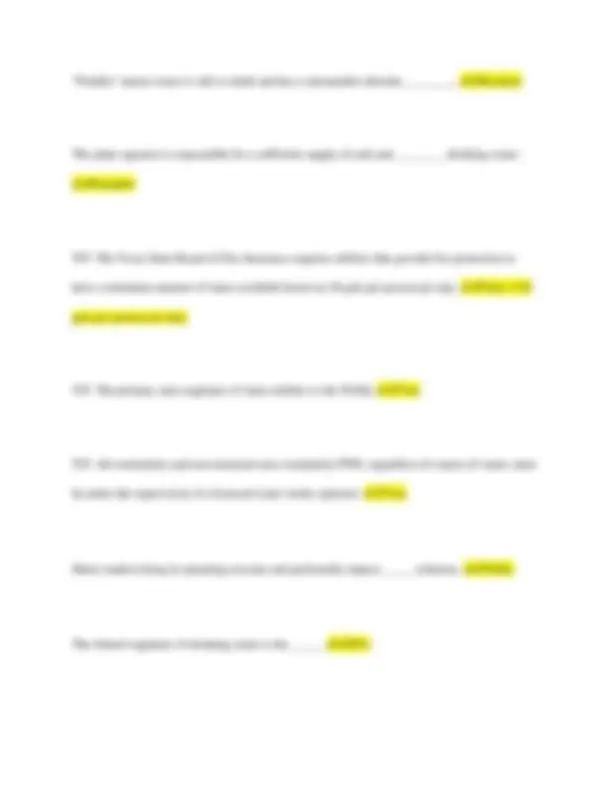
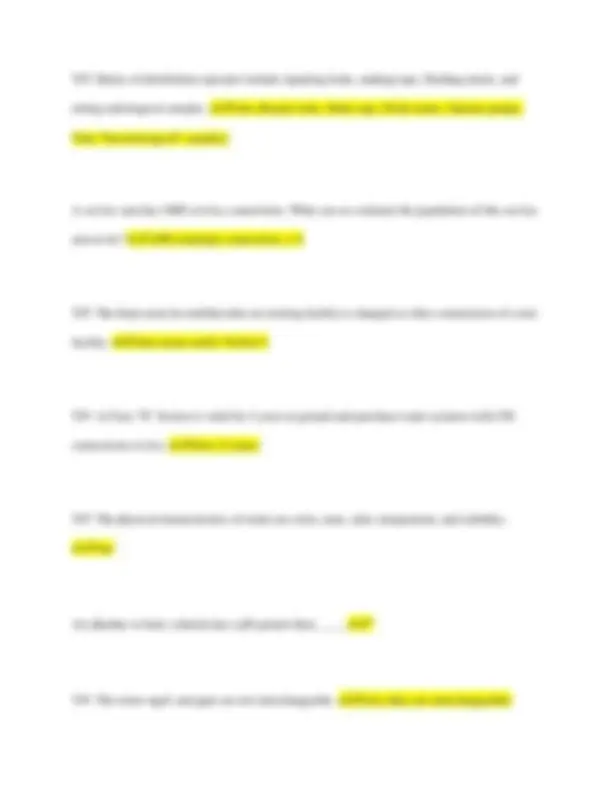
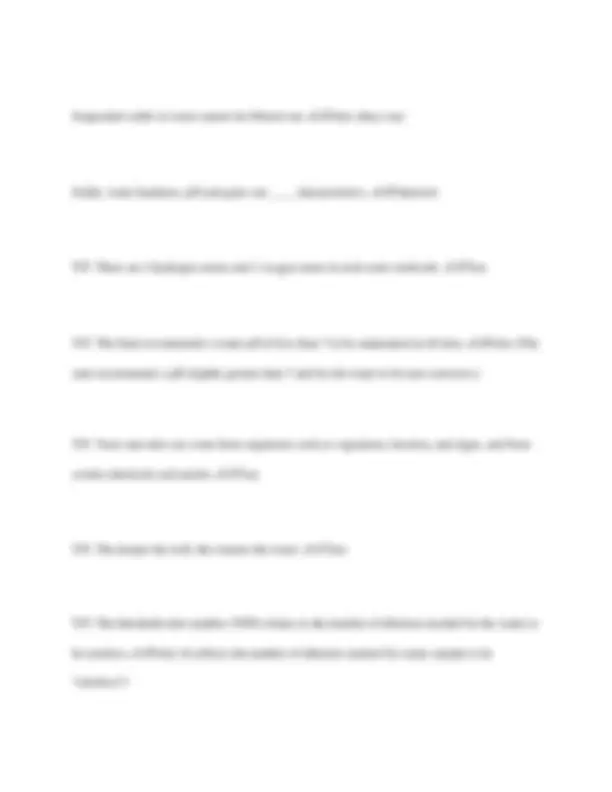
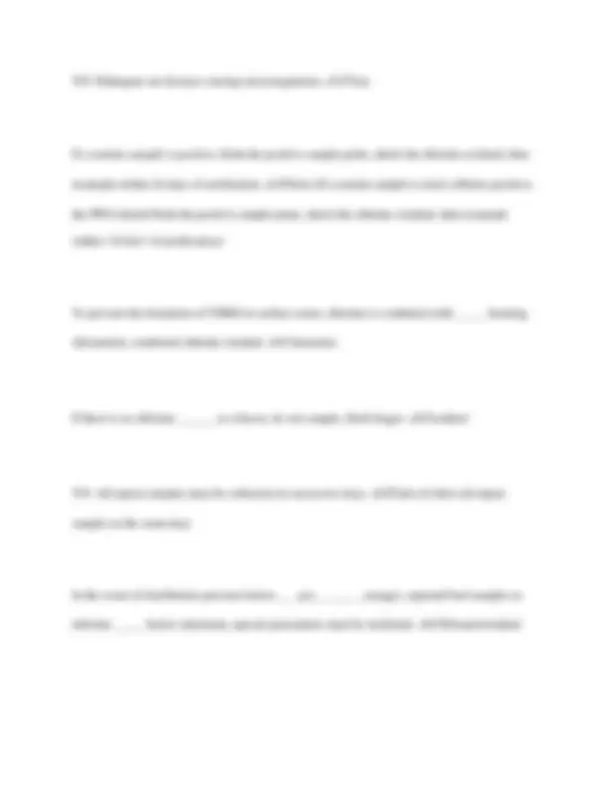
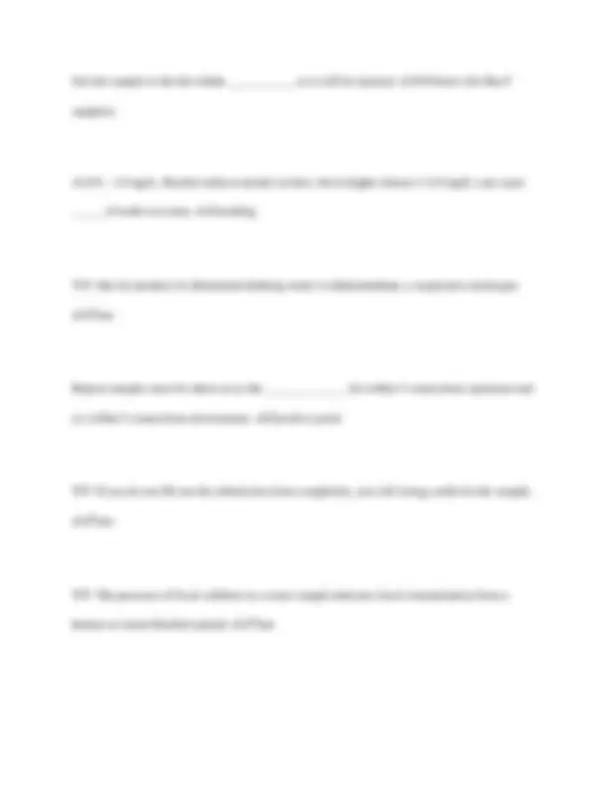
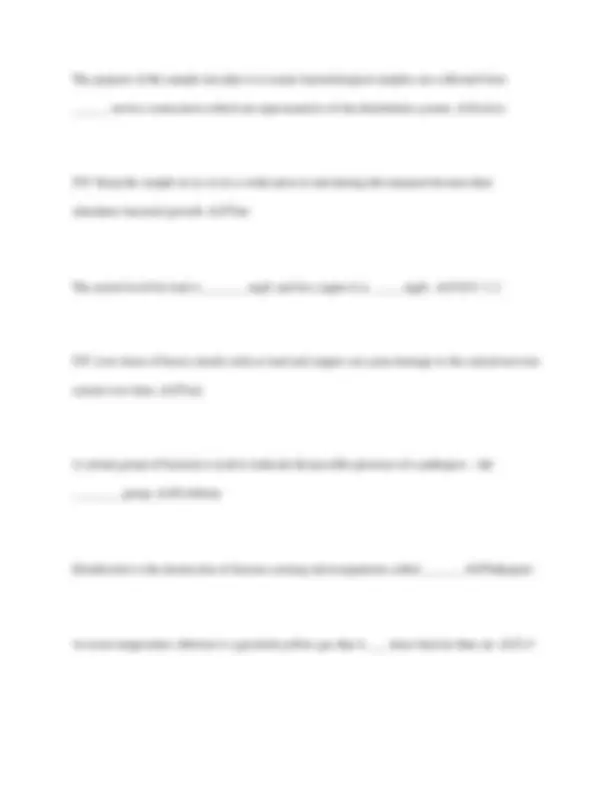
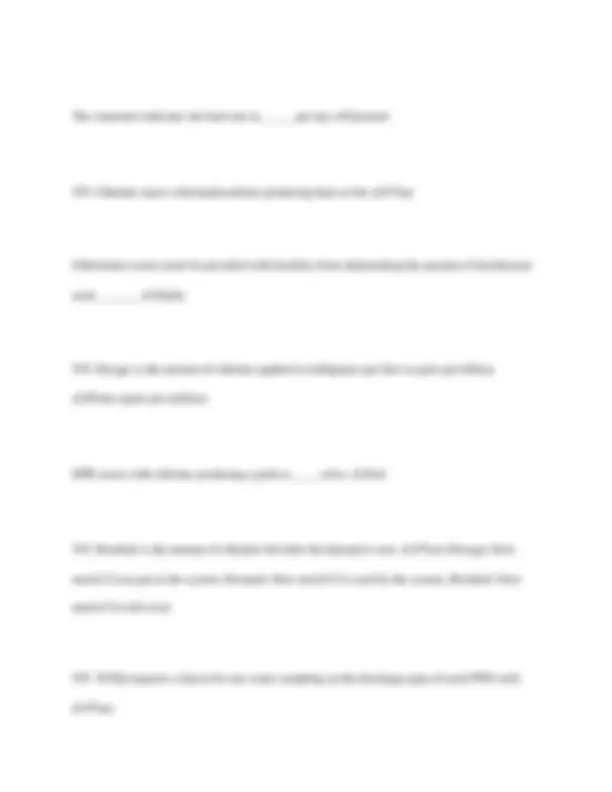
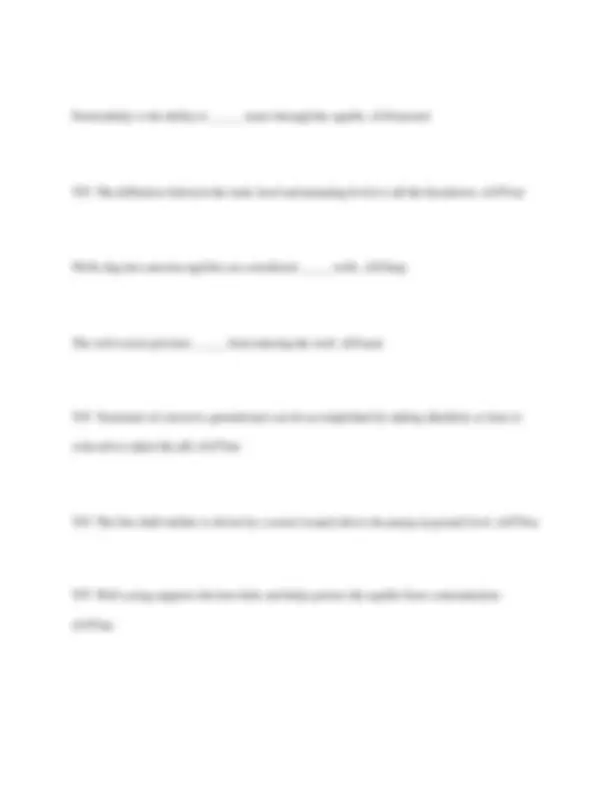
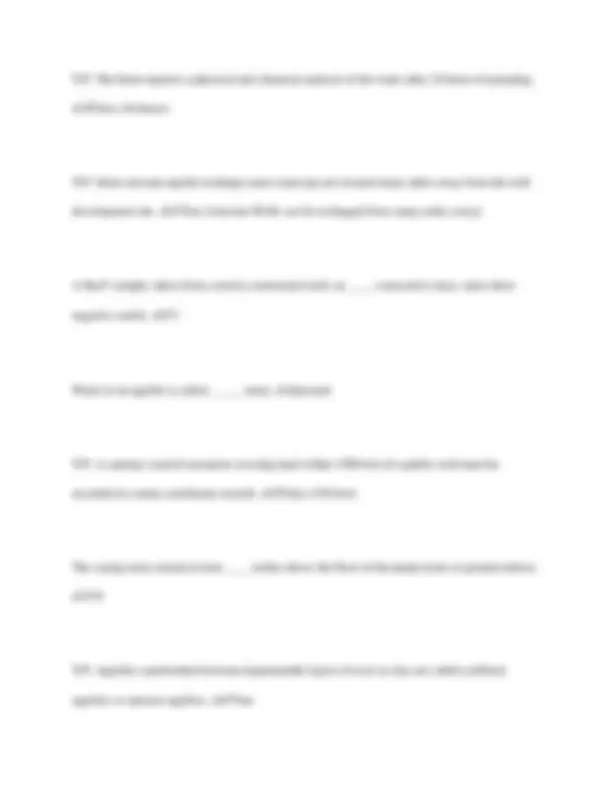
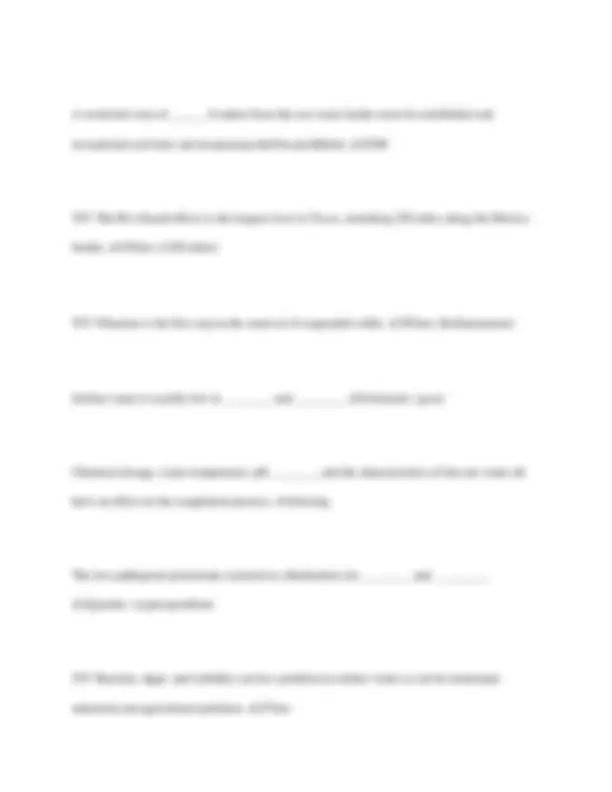
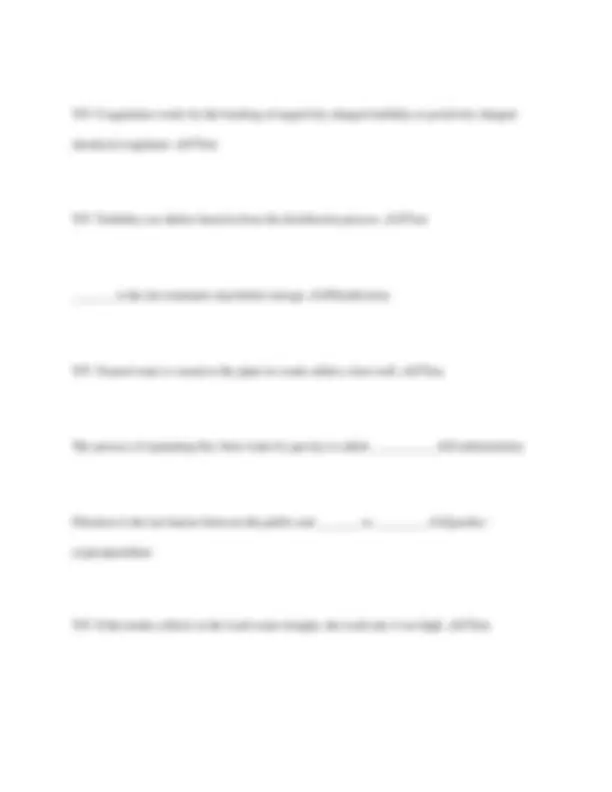
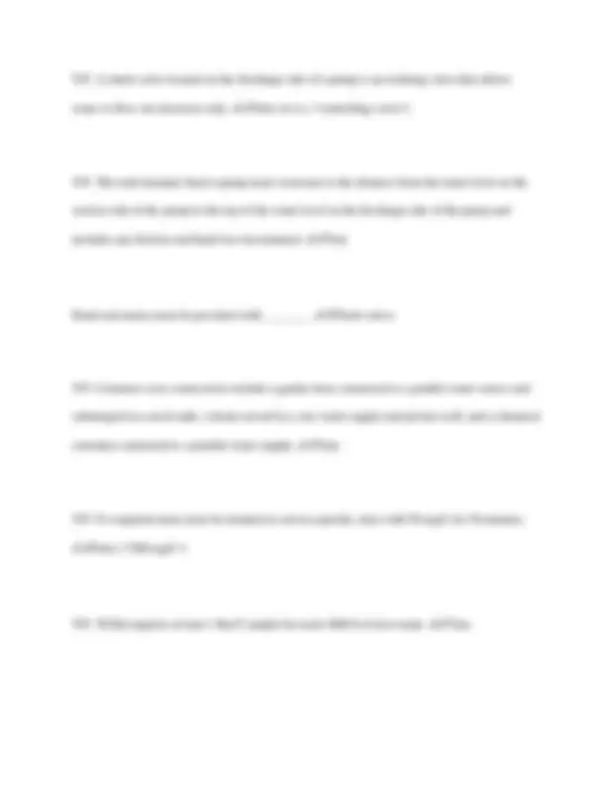
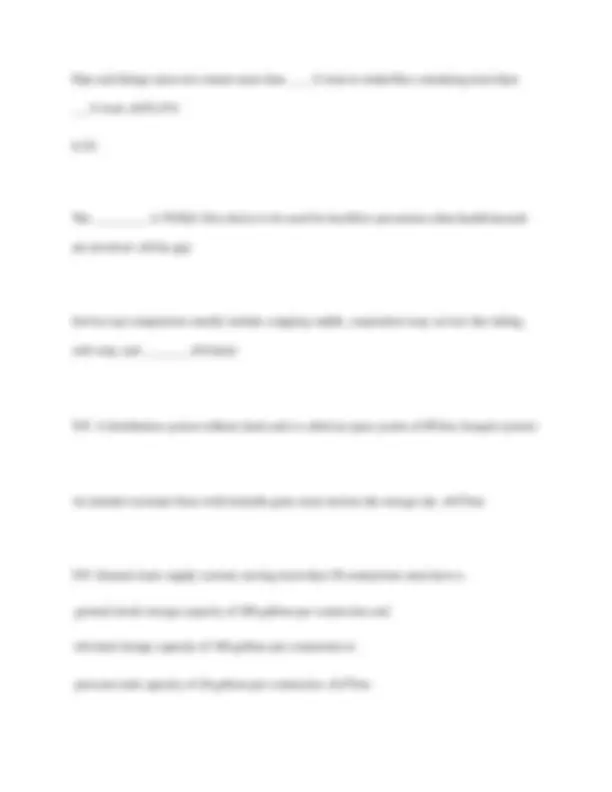
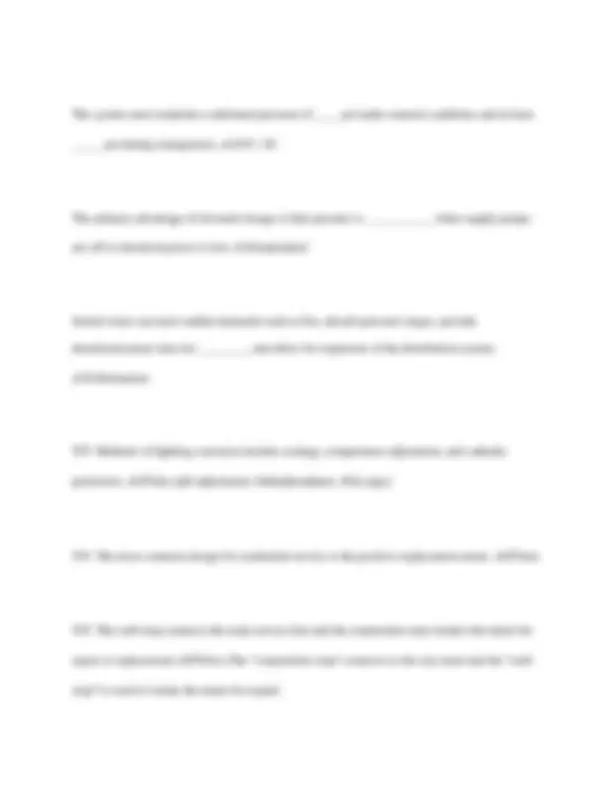
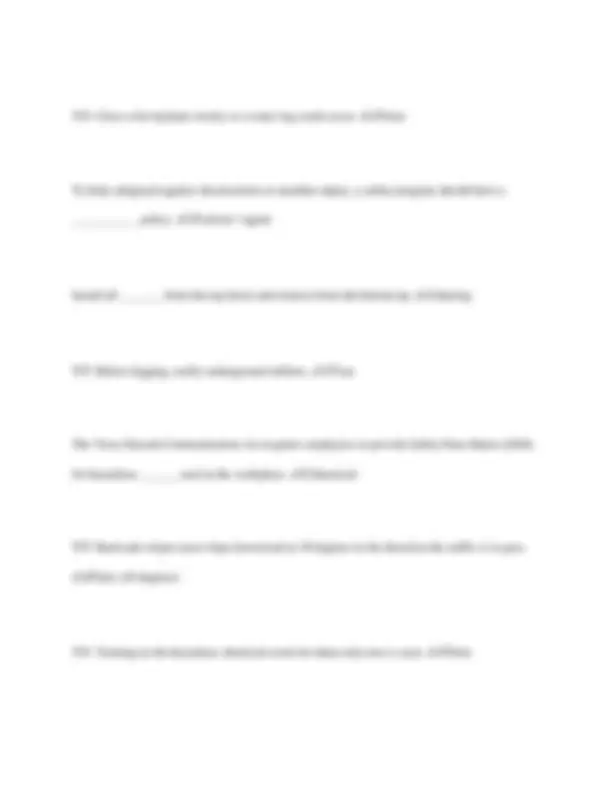
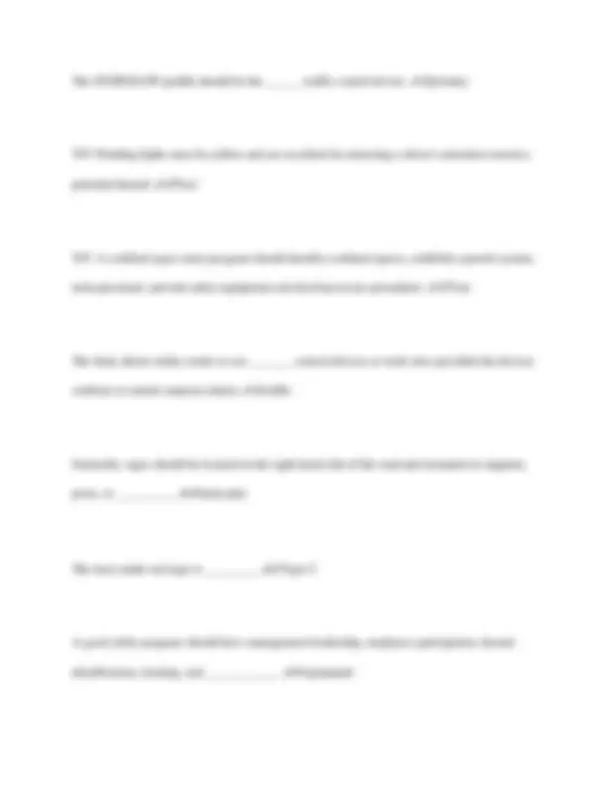
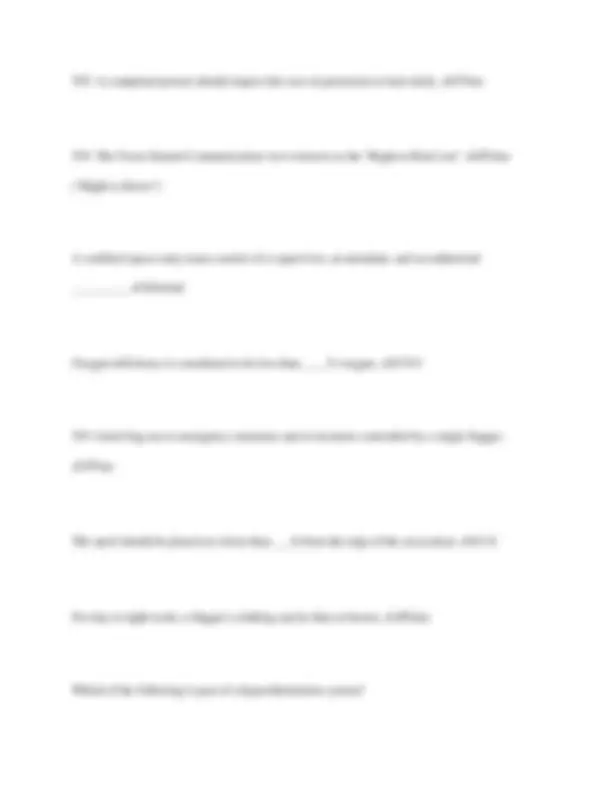
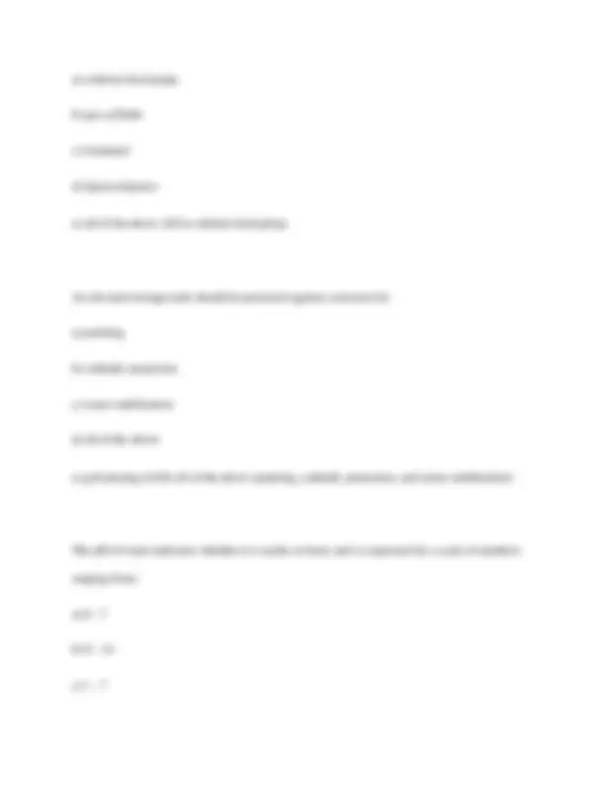
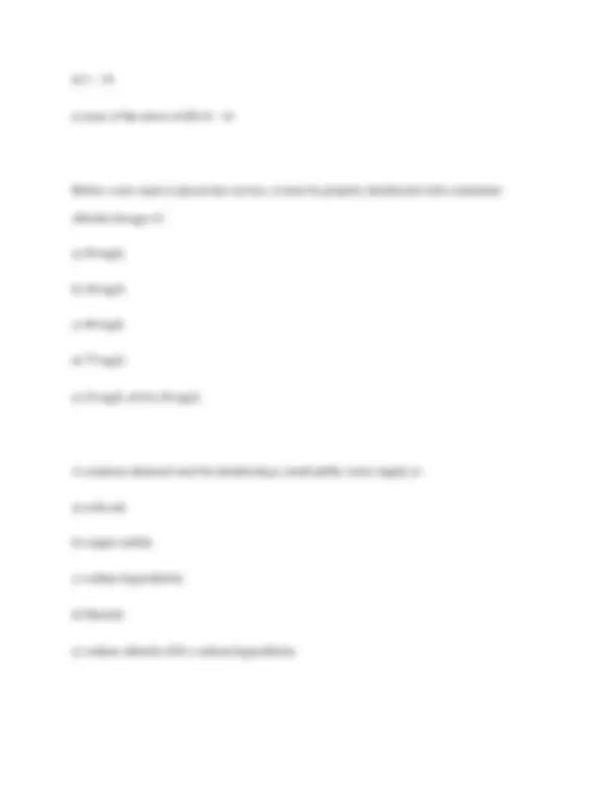
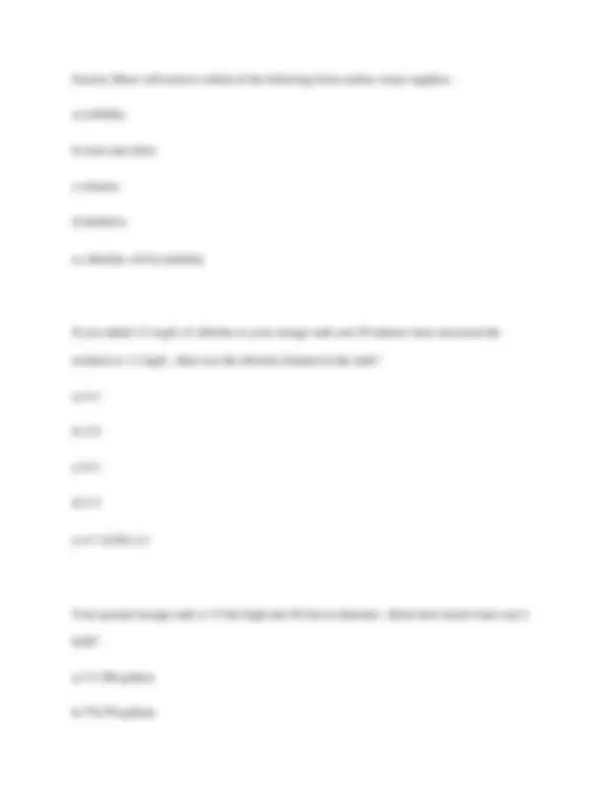
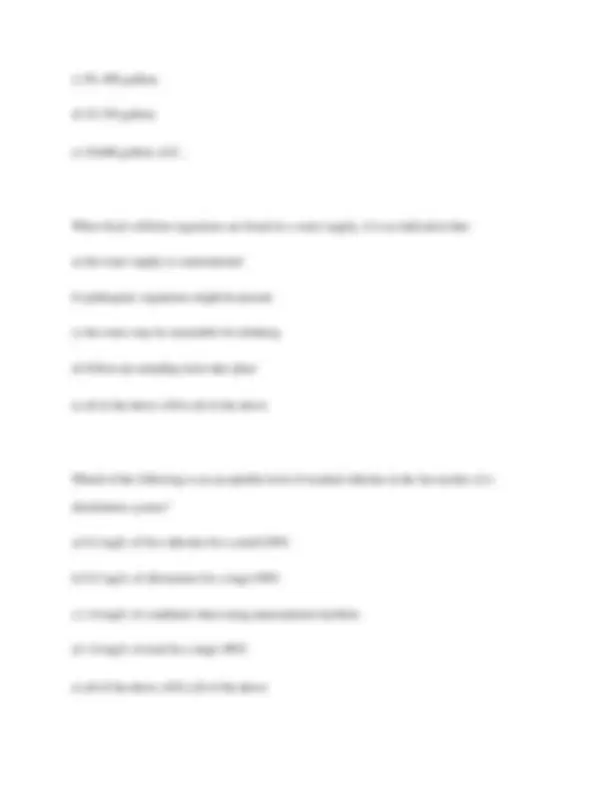
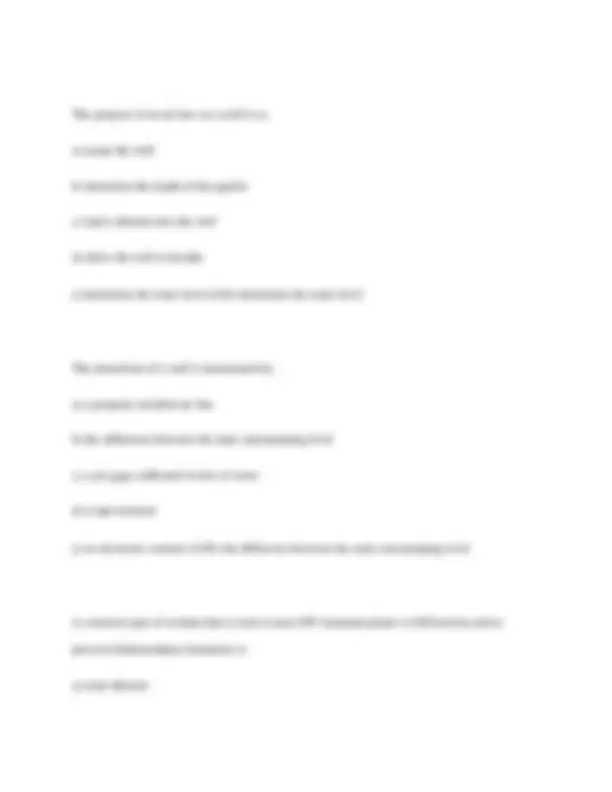
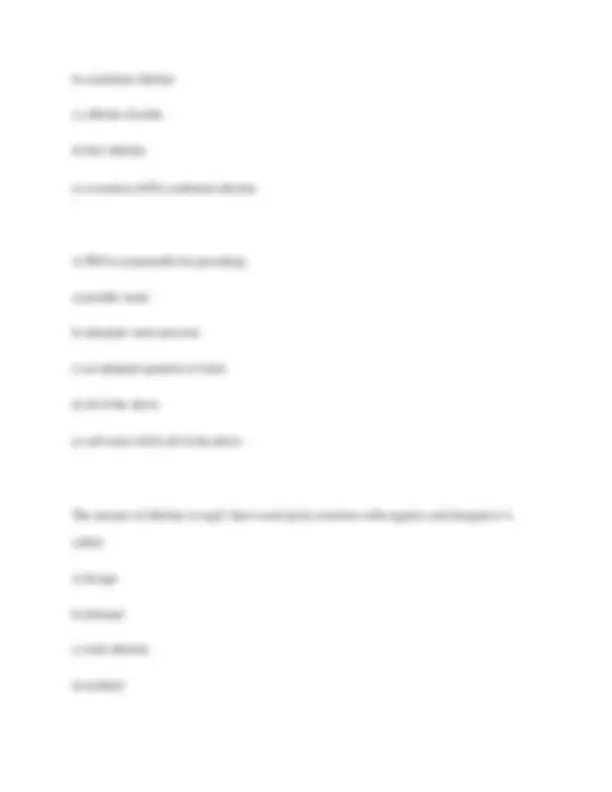
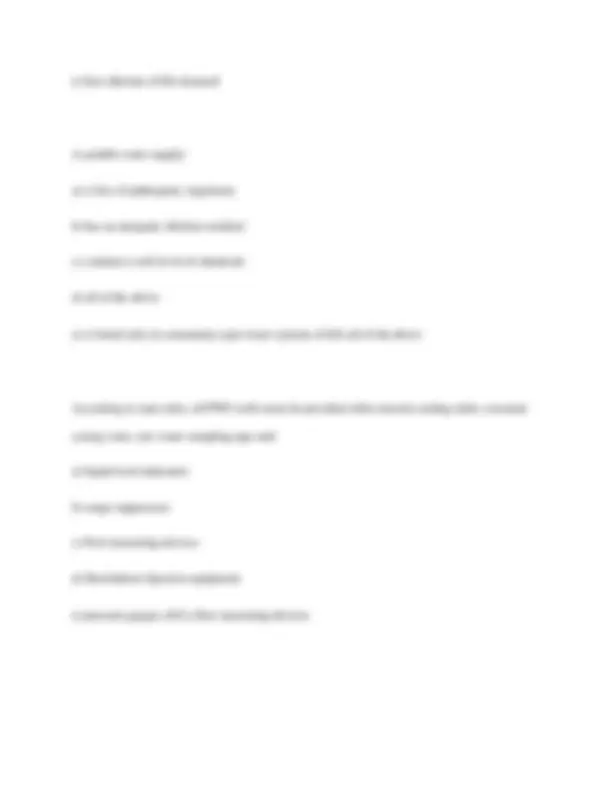


Study with the several resources on Docsity

Earn points by helping other students or get them with a premium plan


Prepare for your exams
Study with the several resources on Docsity

Earn points to download
Earn points by helping other students or get them with a premium plan
Community
Ask the community for help and clear up your study doubts
Discover the best universities in your country according to Docsity users
Free resources
Download our free guides on studying techniques, anxiety management strategies, and thesis advice from Docsity tutors
A comprehensive set of true/false questions and answers related to the texas commission on environmental quality (tceq) class d water operator license exam. It covers various aspects of water treatment, distribution, and safety, including water quality parameters, disinfection methods, and regulatory requirements. A valuable resource for individuals preparing for the class d water operator license exam in texas.
Typology: Exams
1 / 32

This page cannot be seen from the preview
Don't miss anything!

























T/F: In Texas, about 75% of all water is used for commercial, industrial, or agricultural purposes. ✔✔True
Water covers approximately ________ of Earth's surface. ✔✔71%
Drought is an extended period when a region receives a deficiency in its ________ water supply. ✔✔atmospheric, ground, or surface
T/F: Only about 1 gallon of tap water per person/day is used for drinking and cooking ✔✔True
Excluding outside water use, the average household uses about _______ gallons of water per month for inside use ✔✔2,
T/F: Only 3% of all the fresh water on earth can be easily accessed for use. ✔✔False (only 1%)
T/F: In 1978, the Texas Department of Health (TDH) assumed primacy over the Safe Drinking Water Act from the EPA. ✔✔True
T/F: PWS officials should be pro-active in their approach to terrorism. ✔✔True
_________ permits the owner of a well to pump as much water as desired, even if the water is drained from beneath the land of others. ✔✔Rule of Capture
In Texas, agricultural water demand accounts for about ___% of the total water used. ✔✔57%
T/F: An example of a non-transient non-community PWS is a rural school. ✔✔True
Monitoring average and maximum daily water ______ enables us to plan ahead for growth. ✔✔Demand
T/F: The Safe Drinking Water Act sets standards for drinking water including physical, chemical, bacteriological, and radiological characteristics. ✔✔True
T/F: Duties of distribution operator include repairing leaks, making taps, flushing mains, and taking radiological samples. ✔✔False (Repair leaks, Make taps, Flush mains, Operate pumps, Take bacteriological samples)
A service area has 1000 service connections. What can we estimate the population of this service area to be? ✔✔3,000 (multiply connections x 3)
T/F: The State must be notified after an existing facility is changed or after construction of a new facility. ✔✔False (must notify before)
T/F: A Class "D" license is valid for 2 years at ground and purchase water systems with 250 connections or less. ✔✔False (3 years)
T/F: The physical characteristics of water are color, taste, odor, temperature, and turbidity. ✔✔True
An alkaline or basic solution has a pH greater than ____. ✔✔ 7
T/F: The terms mg/L and ppm are not interchangeable. ✔✔False (they are interchangeable)
Suspended solids in water cannot be filtered out. ✔✔False (they can)
Solids, water hardness, pH and gases are ____ characteristics. ✔✔Chemical
T/F: There are 2 hydrogen atoms and 1 oxygen atom in each water molecule. ✔✔True
T/F: The State recommends a water pH of less than 7 to be maintained at all time. ✔✔False (The state recommends a pH slightly greater than 7 and for the water to be non-corrosive.)
T/F: Taste and odor can come from organisms such as vegetation, bacteria, and algae, and from certain chemicals and metals. ✔✔True
T/F: The deeper the well, the warmer the water. ✔✔True
T/F: The threshold odor number (TON) relates to the number of dilutions needed for the water to be tasteless. ✔✔False (It reflects the number of dilutions needed for water sample to be odorless)
T/F: The State recommends a maximum total dissolved solids content of 500 mg/L ✔✔False (The state recommends that TDS not exceed 1000 mg/L)
There are 3 common gases found in water: methane, carbon dioxide, and __________ ___________. ✔✔hydrogen sulfide
T/F: Turbidity must be limited because it shelters and nourishes bacteria and interferes with disinfection. ✔✔True
T/F: Bleach or alcohol require less contact time than flaming to disinfect a faucet. ✔✔False (flaming requires less contact time)
T/F: The "primary limits" refer to chemicals with maximum contaminant levels that can be exceeded. ✔✔False (refers to chemicals with maximum contaminant levels (MCLs) that CANNOT be exceeded.)
T/F: The term "total coliform" means fecal and non-fecal coliform. ✔✔True
T/F: Pathogens are disease-causing microorganisms. ✔✔True
If a routine sample is positive, flush the positive sample point, check the chlorine residual, then resample within 24 days of notification. ✔✔False (If a routine sample is total coliform-positive, the PWS should flush the positive sample point, check the chlorine residual, then resample within 24 hrs of notification)
To prevent the formation of THMS in surface water, chlorine is combined with _____ forming chloramine, combined chlorine residual. ✔✔Ammonia
If there is no chlorine ______ at a faucet, do not sample, flush longer. ✔✔residual
T/F: All repeat samples must be collected on successive days. ✔✔False (Collect all repeat sample on the same day)
In the event of distribution pressure below ___ psi, _______ outages, repeated bad samples or chlorine _____ below minimum, special precautions must be instituted. ✔✔20/water/residual
The purpose of the sample site plan is to assure bacteriological samples are collected from ______ service connections which are representative of the distribution system. ✔✔active
T/F: Keep the sample in ice or in a cooler prior to and during lab transport because heat stimulates bacterial growth. ✔✔True
The action level for lead is _______ mg/L and for copper it is _____ mg/L. ✔✔.015 / 1.
T/F: Low doses of heavy metals such as lead and copper can cause damage to the central nervous system over time. ✔✔True
A certain group of bacteria is used to indicate the possible presence of a pathogen--- the ________ group. ✔✔Coliform
Disinfection is the destruction of disease-causing microorganisms called ______. ✔✔Pathogens
At room temperature chlorine is a greenish-yellow gas that is ___ times heavier than air. ✔✔2.
The State requires ________ to be kept in stock for disinfecting new water lines. ✔✔Calcium hypochlorite
T/F: Hypochlorinators consist of a mixing tank and chemical solution feed pump. ✔✔True
A full-face self-contained breathing apparatus or supplied air respirator must be readily accessible outside the fire station when chlorine gas is used. ✔✔False (A full-face self-contained breathing apparatus (SCBA) or supplied air respirator that meets OSHA standards shall be readily accessible outside the chlorinator room when chlorine gas is used.)
T/F: All public water systems must have chlorination facilities. ✔✔True
If chlorine enters the eyes, flush with running cool water for at least ___ minutes and seek medical attention. ✔✔15 minutes
Liquid bleach used in PWS must be ______ approved. ✔✔NSF
The rotameter indicates the feed rate in _____ per day ✔✔pounds
T/F: Chlorine reacts with hydrocarbons producing heat or fire ✔✔True
Chlorinator rooms must be provided with facilities from determining the amount of disinfectant used _______ ✔✔daily
T/F: Dosage is the amount of chlorine applied in milligrams per liter or parts per billion. ✔✔False (parts per million)
DPD reacts with chlorine producing a pink to ____ color. ✔✔red
T/F: Residual is the amount of chlorine left after the demand is met. ✔✔True (Dosage: How much Cl you put in the system, Demand: How much Cl is used by the system, Residual: How much Cl is left over)
T/F: TCEQ requires a faucet for raw water sampling on the discharge pipe of each PWS well. ✔✔True
Permeability is the ability to _____ water through the aquifer. ✔✔transmit
T/F: The difference between the static level and pumping level is call the drawdown. ✔✔True
Wells dug into artesian aquifers are considered _____ wells. ✔✔deep
The well screen prevents _____ from entering the well. ✔✔sand
T/F: Treatment of corrosive groundwater can be accomplished by adding alkalinity as lime or soda ash to adjust the pH. ✔✔True
T/F: The line shaft turbine is driven by a motor located above the pump at ground level. ✔✔True
T/F: Well casing supports the bore hole and helps protect the aquifer from contamination. ✔✔True
Three ways to measure water levels is the wetted tape, electric sounder, and the ______. ✔✔airline (most often used)
A well drilled into a water table aquifer is usually a ______ well. ✔✔Shallow
Abandoned wells, not plugged, within ___ mile of a proposed well site must be reported to TCEQ. ✔✔1/
The State requires wells be protected by ______-______ fences or locked well houses. ✔✔Intruder-resistant
Groundwater is usually clear and void of __________. ✔✔bacteria
TCEQ defines "complete treatment" as the following sequence of processes: pretreatment disinfection, taste and odor control, continuous coagulation, filtration, sedimentation, terminal disinfection, and covered storage. ✔✔False
(1. Pretreatment disinfection
4. Sedimentation
5. Filtration
T/F: Most solids should be removed in the filtration step. ✔✔False (Sedimentation)
T/F: TCEQ requires filtered water to be 0.3 NTUs or less in at least 95% of measurements each month. ✔✔True
Destratification is the mixing of lake water by compressed air to prevent layers of different __________ from developing. ✔✔temperature
All PWS in Texas are required to use ________ as the final disinfectant. ✔✔chlorine
T/F: Powdered activated carbon (PAC) is commonly used to treat iron and manganese. ✔✔False (removes the tastes and odors usually caused by dead and decaying algae and vegetation)
T/F: Coagulation works by the bonding of negatively charged turbidity to positively charged chemical coagulants. ✔✔True
T/F: Turbidity can shelter bacteria from the disinfection process. ✔✔True
_______ is the last treatment step before storage. ✔✔Disinfection
T/F: Treated water is stored at the plant in a tank called a clear well. ✔✔True
The process of separating floc from water by gravity is called: __________ ✔✔sedimentation
Filtration is the last barrier between the public and _______ or ________. ✔✔giardia / cryptosporidium
T/F: If the media collects in the wash water troughs, the wash rate is too high. ✔✔True
T/F: A check valve located on the discharge side of a pump is an isolating valve that allows water to flow one direction only. ✔✔False (it is a controlling valve)
T/F: The total dynamic head a pump must overcome is the distance from the water level on the suction side of the pump to the top of the water level on the discharge side of the pump and includes any friction and head loss encountered. ✔✔True
Dead-end mains must be provided with ________ ✔✔Flush valves
T/F: Common cross connections include a garden hose connected to a potable water source and submerged in a stock tank, a home served by a city water supply and private well, and a chemical container connected to a potable water supply. ✔✔True
T/F: If a repaired main must be returned to service quickly, does with 50 mg/L for 30 minutes. ✔✔False (500 mg/L)
T/F: TCEQ requires at least 1 BacT sample for each 1000 ft of new main. ✔✔True